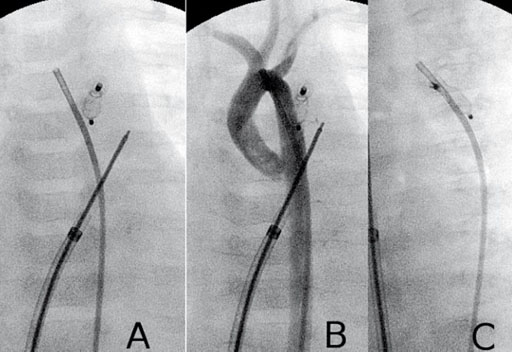Surgeons Use Non-Surgical Technique to Repair Heart Defect in Premature Babies
By MedImaging International staff writers
Posted on 20 Dec 2016
Surgeons in the US have used a new, innovative, minimally invasive technique to repair a common heart defect, called Patent Ductus Arteriosus (PDA), in premature babies.Posted on 20 Dec 2016
The surgeons successfully performed the catheter-based PDA procedure on babies weighing only 755 grams. To perform the procedure the surgeon uses ultrasound guidance to guide a catheter from a vein in the leg of the baby, to the heart, and then closes the ductus arteriosus. The procedure can be performed in a neonatal Intensive Care Unit (ICU) and takes only a number of minutes.

Image: A closure of the Patent Ductus Arteriosus (PDA) in a baby (Photo courtesy of Cedars-Sinai Heart Institute).
The results of the study were published in the December 2016 issue of the Journal of the American College of Cardiology: Cardiovascular Interventions. The PDA procedure was successful in 21 of the 24 premature infants that took part in the study, the other three infants underwent successful surgical repair of the heart defect. All of the babies were at between 24 and 32 weeks' gestation.
The technique was developed by Evan M. Zahn, MD, a congenital heart disease expert, and Alistair Phillips, MD, a pediatric cardiac surgeon, both from the Cedars-Sinai Heart Institute (Los Angeles, CA).
Director of the Cedars-Sinai Heart Institute Eduardo Marbán, MD, PhD, said, "The development of catheter-based procedures for infants is a sea change in the treatment of congenital heart disease. As Dr. Zahn and his team further develop these techniques, parents will no longer have to choose between the risks of surgery and the risks of medications, and babies will get a healthier start in life. We can use these same techniques on older children and adults with congenital heart disease. It is always better for the patient when we can treat a condition without subjecting the patient to the risks and discomfort of surgery."
Related Links:
Cedars-Sinai Heart Institute














